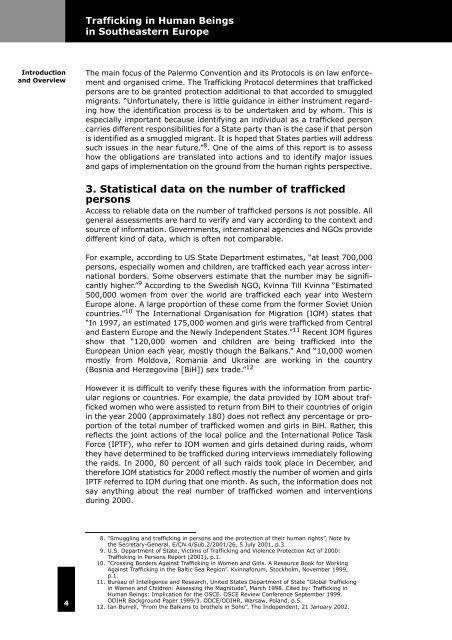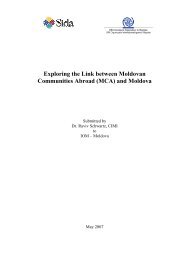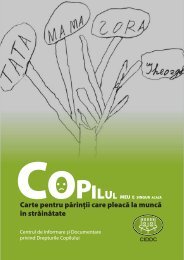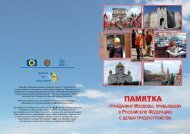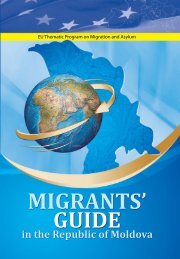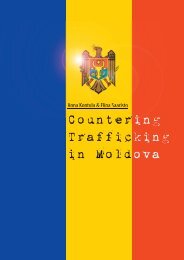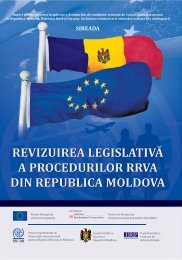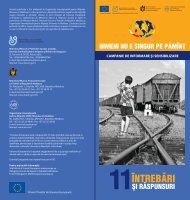Trafficking in Human Beings in Southeastern Europe - Iom
Trafficking in Human Beings in Southeastern Europe - Iom
Trafficking in Human Beings in Southeastern Europe - Iom
- No tags were found...
Create successful ePaper yourself
Turn your PDF publications into a flip-book with our unique Google optimized e-Paper software.
<strong>Traffick<strong>in</strong>g</strong> <strong>in</strong> <strong>Human</strong> Be<strong>in</strong>gs<strong>in</strong> <strong>Southeastern</strong> <strong>Europe</strong>Introductionand OverviewThe ma<strong>in</strong> focus of the Palermo Convention and its Protocols is on law enforcementand organised crime. The <strong>Traffick<strong>in</strong>g</strong> Protocol determ<strong>in</strong>es that traffickedpersons are to be granted protection additional to that accorded to smuggledmigrants. “Unfortunately, there is little guidance <strong>in</strong> either <strong>in</strong>strument regard<strong>in</strong>ghow the identification process is to be undertaken and by whom. This isespecially important because identify<strong>in</strong>g an <strong>in</strong>dividual as a trafficked personcarries different responsibilities for a State party than is the case if that personis identified as a smuggled migrant. It is hoped that States parties will addresssuch issues <strong>in</strong> the near future.” 8 . One of the aims of this report is to assesshow the obligations are translated <strong>in</strong>to actions and to identify major issuesand gaps of implementation on the ground from the human rights perspective.3. Statistical data on the number of traffickedpersonsAccess to reliable data on the number of trafficked persons is not possible. Allgeneral assessments are hard to verify and vary accord<strong>in</strong>g to the context andsource of <strong>in</strong>formation. Governments, <strong>in</strong>ternational agencies and NGOs providedifferent k<strong>in</strong>d of data, which is often not comparable.For example, accord<strong>in</strong>g to US State Department estimates, “at least 700,000persons, especially women and children, are trafficked each year across <strong>in</strong>ternationalborders. Some observers estimate that the number may be significantlyhigher.” 9 Accord<strong>in</strong>g to the Swedish NGO, Kv<strong>in</strong>na Till Kv<strong>in</strong>na “Estimated500,000 women from over the world are trafficked each year <strong>in</strong>to Western<strong>Europe</strong> alone. A large proportion of these come from the former Soviet Unioncountries.” 10 The International Organisation for Migration (IOM) states that“In 1997, an estimated 175,000 women and girls were trafficked from Centraland Eastern <strong>Europe</strong> and the Newly Independent States.” 11 Recent IOM figuresshow that “120,000 women and children are be<strong>in</strong>g trafficked <strong>in</strong>to the<strong>Europe</strong>an Union each year, mostly though the Balkans.” And “10,000 womenmostly from Moldova, Romania and Ukra<strong>in</strong>e are work<strong>in</strong>g <strong>in</strong> the country(Bosnia and Herzegov<strong>in</strong>a [BiH]) sex trade.” 12However it is difficult to verify these figures with the <strong>in</strong>formation from particularregions or countries. For example, the data provided by IOM about traffickedwomen who were assisted to return from BiH to their countries of orig<strong>in</strong><strong>in</strong> the year 2000 (approximately 180) does not reflect any percentage or proportionof the total number of trafficked women and girls <strong>in</strong> BiH. Rather, thisreflects the jo<strong>in</strong>t actions of the local police and the International Police TaskForce (IPTF), who refer to IOM women and girls deta<strong>in</strong>ed dur<strong>in</strong>g raids, whomthey have determ<strong>in</strong>ed to be trafficked dur<strong>in</strong>g <strong>in</strong>terviews immediately follow<strong>in</strong>gthe raids. In 2000, 80 percent of all such raids took place <strong>in</strong> December, andtherefore IOM statistics for 2000 reflect mostly the number of women and girlsIPTF referred to IOM dur<strong>in</strong>g that one month. As such, the <strong>in</strong>formation does notsay anyth<strong>in</strong>g about the real number of trafficked women and <strong>in</strong>terventionsdur<strong>in</strong>g 2000.48.“Smuggl<strong>in</strong>g and traffick<strong>in</strong>g <strong>in</strong> persons and the protection of their human rights”, Note bythe Secretary-General, E/CN.4/Sub.2/2001/26, 5 July 2001, p.3.9. U.S. Department of State, Victims of <strong>Traffick<strong>in</strong>g</strong> and Violence Protection Act of 2000:<strong>Traffick<strong>in</strong>g</strong> <strong>in</strong> Persons Report (2001), p.1.10.“Cross<strong>in</strong>g Borders Aga<strong>in</strong>st <strong>Traffick<strong>in</strong>g</strong> <strong>in</strong> Women and Girls.A Resource Book for Work<strong>in</strong>gAga<strong>in</strong>st <strong>Traffick<strong>in</strong>g</strong> <strong>in</strong> the Baltic Sea Region”. Kv<strong>in</strong>naforum, Stockholm, November 1999,p.1.11.Bureau of Intelligence and Research, United States Department of State “Global <strong>Traffick<strong>in</strong>g</strong><strong>in</strong> Women and Children: Assess<strong>in</strong>g the Magnitude”, March 1998. Cited by: <strong>Traffick<strong>in</strong>g</strong> <strong>in</strong><strong>Human</strong> Be<strong>in</strong>gs: Implication for the OSCE. OSCE Review Conference September 1999.ODIHR Background Paper 1999/3. ODCE/ODIHR, Warsaw, Poland, p.5.12.Ian Burrell, “From the Balkans to brothels <strong>in</strong> Soho”.The Independent, 21 January 2002.


